Environmental Transformations in the Area of the Kuźnica Warężyńska Sand Mine, Southern Poland
Abstract
1. Introduction
2. Materials and Methods
2.1. Cartographic Analysis
2.2. Research on Fauna and Flora
2.3. Study Area Characteristics
3. Results and Discussion
3.1. Changes in Land Use
3.2. Depletion of Groundwater Resources
3.3. Changes in Groundwater Circulation Conditions
3.4. Transformation of the Hydrological Conditions
3.5. Changes in Groundwater and Surface Water Chemistry
3.6. Transformations of the Biotic Environment
4. Conclusions
- The article discusses environmental transformations in the area of the Kuźnica Warężyńska sand mine in southern Poland over the years 1944–2015. A comprehensive ecological analysis was carried out concerning spatial development, mining activity, hydrogeological and hydrological conditions as well as the biotic environment. During the research period, arable land was practically liquidated, and after periodic activity of sand mine in 1967–2002, a water reservoir was created in 2003–2005.
- Mining activities and the creation of a water reservoir resulted in two times changes in groundwater circulation conditions, depletion of the aquifer due to a reduction in the surface area of the aquifer and a decrease in the value of hydrogeological parameters. The lowering of the groundwater aquifer category from regional to local. Changes in the hydrodynamic conditions have resulted in changes in the chemistry of the Quaternary aquifer, which have been manifested by periodically increased SO4, Fe and Mn concentrations. At the same time, the changes resulting from diverse agricultural pressures and urbanisation have been unfavourable.
- The resulting reservoir with an area of 560 ha and a volume of 51 million m3, which is currently the groundwater drainage route, ensures the allows environmental flow and has flood control functions. At the same time, it contributes to the increase of the economic, tourist and recreational attractiveness of the area.
- The extraction of filling sand and the reclamation of a closed mine have various effects on the natural environment. On the one hand, it led to the destruction of primary biocenotic systems. on the other hand, the creation of a water reservoir has contributed to an increase in biodiversity and the formation of valuable phytocoenoses.
- In conclusion, it can be stated that over 75 years of human activity had a favorable economic dimension. In the area of extensive farming, conditioned by the presence of soils with low agricultural valuation, a valuable deposit of filling sands has been exploited, and after the reclamation of the open pit in the water direction, the economic and biocenotic attractiveness of the area has increased. Such a scenario is also documented by experience from other European and world countries.
Author Contributions
Funding
Acknowledgments
Conflicts of Interest
References
- UNEP. Global Environmental Alert Service—Sand, Rarer than One Thinks; UNEP: Athens, Greece, 2014. [Google Scholar]
- Rivier, B.; Seguier, J. Physical and biological effects of gravel extraction in river beds. In Habitat Modification and Freshwater Fisheries; Alabaster, J.S., Ed.; Food and Agriculture Organization U.N.: Rome, Italy, 1985; pp. 131–146. [Google Scholar]
- Ghose, M.K. Land reclamation and protection of environment from the effect of coal mining operation. Mine Technol. 1989, 10, 35–39. [Google Scholar]
- Naveen, S.M. Environmental impact of soil and sand mining: A review. Int. J. Sci. Environ. Technol. 2012, 1, 125–134. [Google Scholar]
- Gavrilitea, M.D. Environmental Impacts of Sand Exploitation. Analysis of Sand Market. Sustainability 2017, 9, 1118. [Google Scholar] [CrossRef]
- Nabegu, A.B. Effect of Sand mining on Ground Water in Kano River Catchment. J. Environ. Earth Sci. 2013, 3, 81–87. [Google Scholar]
- Arbogast, B.F.; Knepper, D.H., Jr.; Langer, W.H. The Human Factor in Mining Reclamation; U.S. Geological Survey Circular: Reston, VA, USA, 2000; Volume 1191, pp. 1–27.
- Damigos, D.; Kaliampakos, D. Assessing the benefits of reclaiming urban quarries: A CVM analysis. Landsc. Urban Plan. 2003, 64, 249–258. [Google Scholar] [CrossRef]
- Kasztelewicz, Z. Rekultywacja Terenów Pogórniczych w Polskich Kopalniach Odkrywkowych; AGH: Kraków, Poland, 2010. [Google Scholar]
- Akande, J.M.; Jimoh, B.O. Quarrying of Sand and Proposed Reclamation Method in Akure, Nigeria. Int. J. Eng. Technol. 2013, 3, 747–756. [Google Scholar]
- Uberman, R.; Ostręga, A. Reclamation and revitalisation of lands after mining activities. Polish achievements and problems. AGH J. Min. Geoengin. 2012, 36, 285–297. [Google Scholar]
- Yuan, J.-G.; Fang, W.; Fan, L.; Chen, Y.; Wang, D.-Q.; Yang, Z.-Y. Soil formation and vegetation establishment on the cliff face of abandoned quarries in the early stages of natural colonization. Restor. Ecol. 2006, 14, 349–356. [Google Scholar] [CrossRef]
- Prach, K.; Řehounková, K.; Řehounek, J.; Konvalinková, J. Ecological restoration of central European mining sites: A summary of a multi-site analysis. Landsc. Res. 2011, 36, 263–268. [Google Scholar] [CrossRef]
- Szumacher, I.; Pabjanek, P. Temporal changes in ecosystem services in European cities in the continental biogeographical region in the period from 1990–2012. Sustainability 2017, 9, 665. [Google Scholar] [CrossRef]
- Legwaila, I.; Lange, E. Landscape restoration and visual quality. Reclamation 2010, 11, 11–13. [Google Scholar]
- Hronček, P. Local quarries and how to use them in geotourism. Acta Geoturistica 2015, 6, 11–20. [Google Scholar]
- Kivinen, S. Sustainable Post-Mining Land Use: Are Closed Metal Mines Abandoned or Re-Used Space? Sustainability 2017, 9, 1705. [Google Scholar] [CrossRef]
- Novák, J.; Konvicka, M. Proximity of valuable habitats affects succession patterns in abandoned quarries. Ecol. Eng. 2006, 26, 113–122. [Google Scholar] [CrossRef]
- Czylok, A.; Rahmonov, O.; Szymczyk, A. Biological diversity in the area of quarries after sand exploitation in the eastern part of Silesian Upland. Teka Komisji Ochrony i Kształtowania Środowiska Przyrodniczego. Oddział Lub. PAN 2008, 5A, 15–22. [Google Scholar]
- Hendrychová, M. Reclamation success in post-mining landscapes in the Czech Republic: A review of pedagogical and biological studies. J. Landsc. Stud. 2008, 1, 63–78. [Google Scholar]
- Natural Water Retention Measures. Science for Environment Policy; European Commission, EurComm DG ENV; European Commission: Brussels, Belgium, 2012; Volume 32, pp. 1–12.
- Israel, A.L.; Lange, E.; Cripps, J. Quarry reclamation in England: A review of techniques. J. Am. Soc. Min. Reclam. 2015, 4, 55–79. [Google Scholar] [CrossRef]
- Ostręga, A.; Uberman, R. Modes of reclamation and redevelopment—Manner of choice, classification and examples. AGH J. Min. Geoengin. 2010, 34, 445–461. [Google Scholar]
- Malinowska, E.; Szumacher, I. Survey of recreationaluse of the Las Kabacki forest nature reserve in Warsaw (Poland). Misc. Geogr. 2013, 17, 12–18. [Google Scholar]
- Kowalewski, Z. Actions for small water retention undertaken in Poland. J. Water Land Dev. 2008, 12, 155–167. [Google Scholar] [CrossRef][Green Version]
- Jakóbczyk, S.; Kowalczyk, A. Chemical composition of groundwater in the area of the flooded sand pit Kuźnica Warężyńska in view of modelling investigations. Biul. PIG 2009, 436, 165–174. [Google Scholar]
- Dulias, R. Landscape planning in areas of sand extraction in the Silesian Upland, Poland. Landsc. Urban Plan. 2010, 95, 91–104. [Google Scholar] [CrossRef]
- Map of the Upper Silesian Industrial District; 1:25,000, Arkusz 3; Zarząd topograficzny Sztabu Generalnego; Archiwum Państwowe w Katowicach: Warszawa, Poland, 1960.
- Topographic Map on a Scale of 1: 25,000, Sheets: 521.44 Psary, 522.33 Łazy, 531.22 Sosnowiec, 532.11 Dąbrowa Górnicza-Strzemieszyce; Główny Urząd Geodezji i Kartografii, Polskie Przedsiębiorstwo Geodezyjno-Kartograficzne: Katowice, Poland, 1988.
- Biernat, S. Szczegółowa Mapa Geologiczna Polski; 1:50000, Arkusz M34-51C, Wojkowice; Wydywnictwo Geologiczne: Warszawa, Poland, 1957. [Google Scholar]
- Geoportal Województwa Śląskiego 2015. Available online: https://www.orsip.pl/geoportal (accessed on 25 March 2020).
- Paniecki, T. Problems with calibration of the detailed map of Poland in 1:25,000 published by the Military Geographical Institute (WIG) in Warsaw. Pol. Prz. Kartogr. 2014, 46, 162–172. [Google Scholar]
- Sobala, M. Application of Austrian cadastral maps in research on land use in the middle of 19th century. Pol. Prz. Kartogr. 2012, 44, 324–333. [Google Scholar]
- Sobala, M.; Rahmonov, O.; Myga-Piątek, U. Historical and contemporary forest ecosystem changes in the Beskid Mountains (southern Poland) between 1848 and 2014. iForest Biogeosciences For. 2017, 10, 939–947. [Google Scholar] [CrossRef]
- Polish Hydrogeological Publications. Available online: https://www.pgi.gov.pl/psh/psh-2/polskie-publikacje-hydrogeologiczne.html (accessed on 3 April 2020).
- Mining Polish Scientific Bibliography. Available online: http://www.sitg.pl/przegladgorniczy/spis-wydawniczy.html (accessed on 3 April 2020).
- Kmiecik, P.; Gwóźdź, R.; Beuch, S. The birds of Kuźnica Warężyńska Reservoir. Ptaki Śląska 2014, 21, 69–85. [Google Scholar]
- Kuter, N. Reclamation of Degraded Landscapes Due to Opencast Mining, Advances in Landscape Architecture. 2013. Available online: http://www.intechopen.com/books/advances-in-landscape-architecture/reclamation-of-degraded-landscapes-due-to-opencast-mining (accessed on 16 October 2017).
- Pavloudakis, F.; Roumpos, C.; Galetakis, M. Public acceptance of surface mining projects and the determination of the marginal environmental cost. Int. J. Min. Reclam. Environ. 2012, 26, 292–308. [Google Scholar] [CrossRef]
- Wagner, J.; Chmura, A.; Siemiński, A. Mapa Hydrogeologiczna Polski; 1:50000, ark. Wojkowice (911); PIG-PIB: Warszawa, Poland, 1997.
- Różkowski, A.; Chmura, A.; Siemiński, A. Użytkowanie Wód Podziemnych Górnośląskiego Zagłębia Węglowego i Jego Obrzeżenia; Prace PIG CLIX: Warszawa, Poland, 1997.
- Mikołajków, J.; Sadurski, A. Główne Zbiorniki Wód Podziemnych w Polsce. LZWP nr 455 Dąbrowa Górnicza (Dawny GZWP nr 455); Informator PSH PIG-PIB: Warszawa, Poland, 2017; pp. 388–389.
- Sawicki, J. Zmiany Naturalnej Infiltracji Opadów do Warstw Wodonośnych pod Wpływem Głębokiego, Górniczego Drenażu; Wyd. Oficyna Wydawnicza Politechniki Wrocławskiej: Wrocław, Poland, 2000. [Google Scholar]
- Kropka, J.; Jagliński, Ł. Recharging infiltration in groundwater basin of Pagoria stream and Kuźnica Warężyńska, Pogoria I, Pogoria II and Pogoria III reservioirs located in the Dąbrowska valley (Silesian Voivodship). Przegląd Górniczy 2015, 12, 124–130. [Google Scholar]
- Kropka, J.; Banaś, B. Changes in chemical composition of groundwaters in the region of area of the “Kuźnica Warężyńska” sand pit (northern part of the Upper Silesian Coal Basin). In Hydrogeology of Urbanized and Industrialized Areas; Kowalczyk, A., Różkowski, A., Eds.; Prace WNoZ: Katowice, Poland, 2005; Volume 2, pp. 97–105. [Google Scholar]
- Rahmonov, O.; Snytko, V.A.; Szczypek, T. Influence of melioration in natural ecological processes of a small river valley (Poland). Geogr. Nat. Resour. 2016, 37, 379–384. [Google Scholar] [CrossRef]
- Krajewski, Ł. Przyroda piaskowni Kuźnica Warężyńska w Dąbrowie Górniczej. cz. 5. ramienice i ich zbiorowiska. Przyr. Górnego Śląska 2011, 65, 5–7. [Google Scholar]
- Frouz, J.; Kalcik, J.; Velichova, V. Factors causing spatial heterogeneity in soil properties, plant cover, and soil fauna in a non-reclaimed post-mining site. Ecol. Eng. 2011, 37, 1910–1913. [Google Scholar] [CrossRef]
- Festin, E.S.; Tigabu, M.; Chileshe, M.N.; Syampunani, S.; Oden, P.C. Progresses in restoration of post-mining landscape in Africa. J. For. Res. 2019, 30, 381–396. [Google Scholar] [CrossRef]
- Classification of Ecological Status, Ecological Potential and Chemical Status, and Assessment of the Status of River Surface Water Bodies in the Śląskie Voivodeship for 2017. Katowice. 2018. Available online: http://www.katowice.wios.gov.pl/monitoring/informacje/stan2017/wody_pow/ocena2017.pdf (accessed on 5 April 2020).
- Aparta, M. Impact of the exploitation of filling sand on the geographical environment of the Czarna Przemsza Valley. Geogr. Studia Diss. 1984, 8, 35–47. [Google Scholar]
- Rahmonov, O.; Różkowski, J.; Szymczyk, A. Is the Vegetation Succession a Threat for Rare and Protected Species in a Sand Quarry? Case Study of the Kuźnica Warężyńska Sand Quarry (Southern Poland). IOP Conf. Ser. Earth Environ. Sci. 2019, 362. [Google Scholar] [CrossRef]
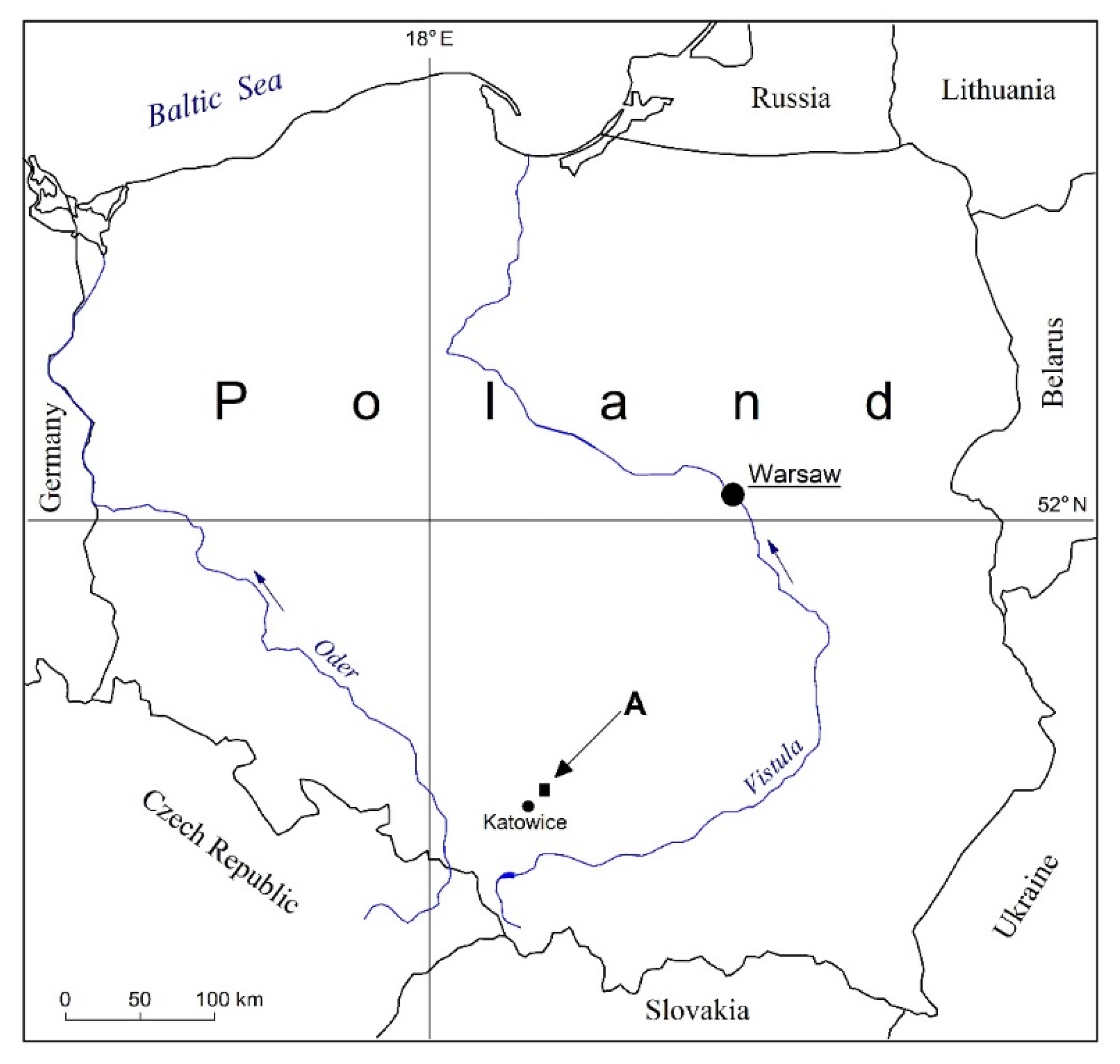
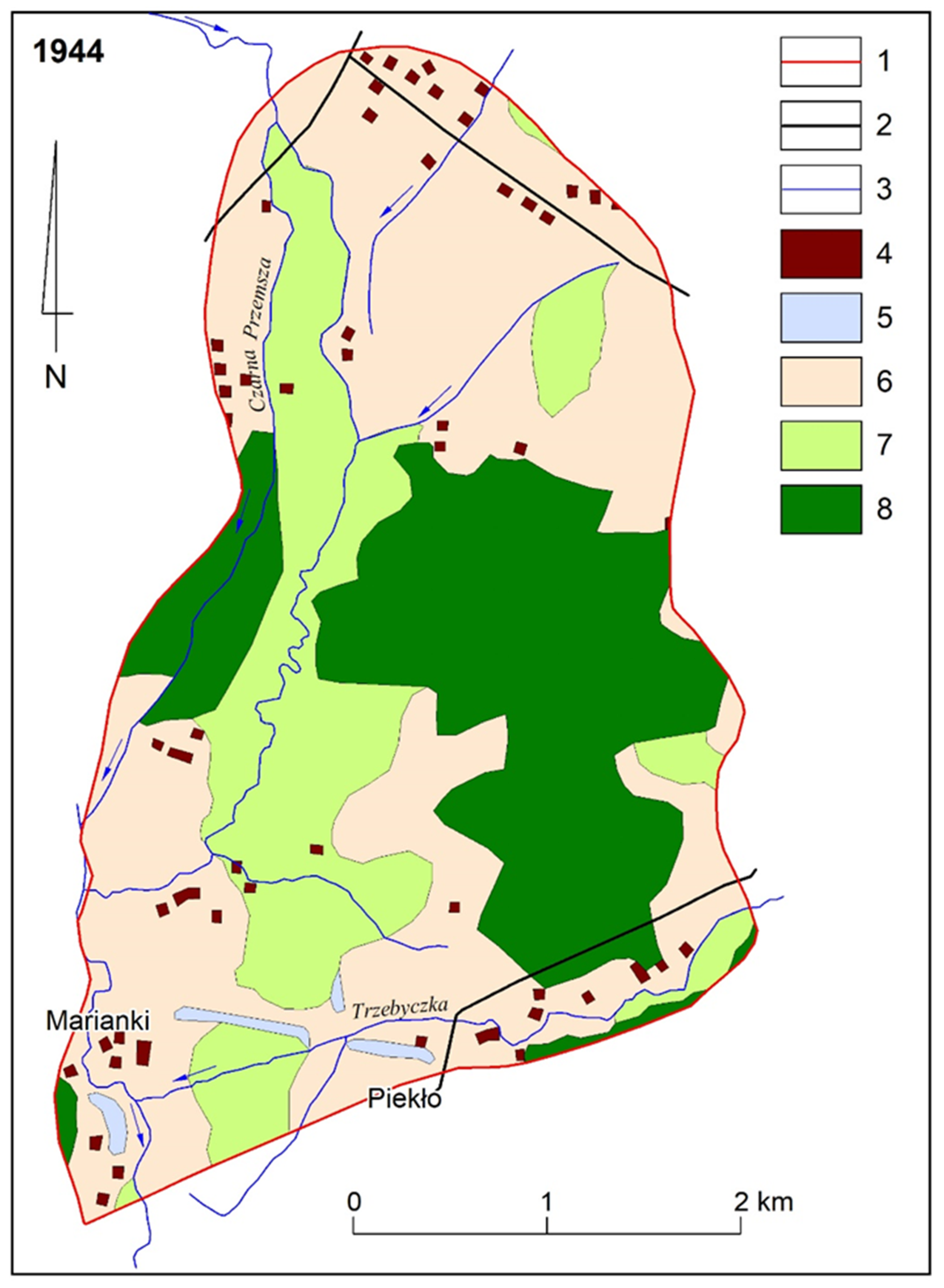
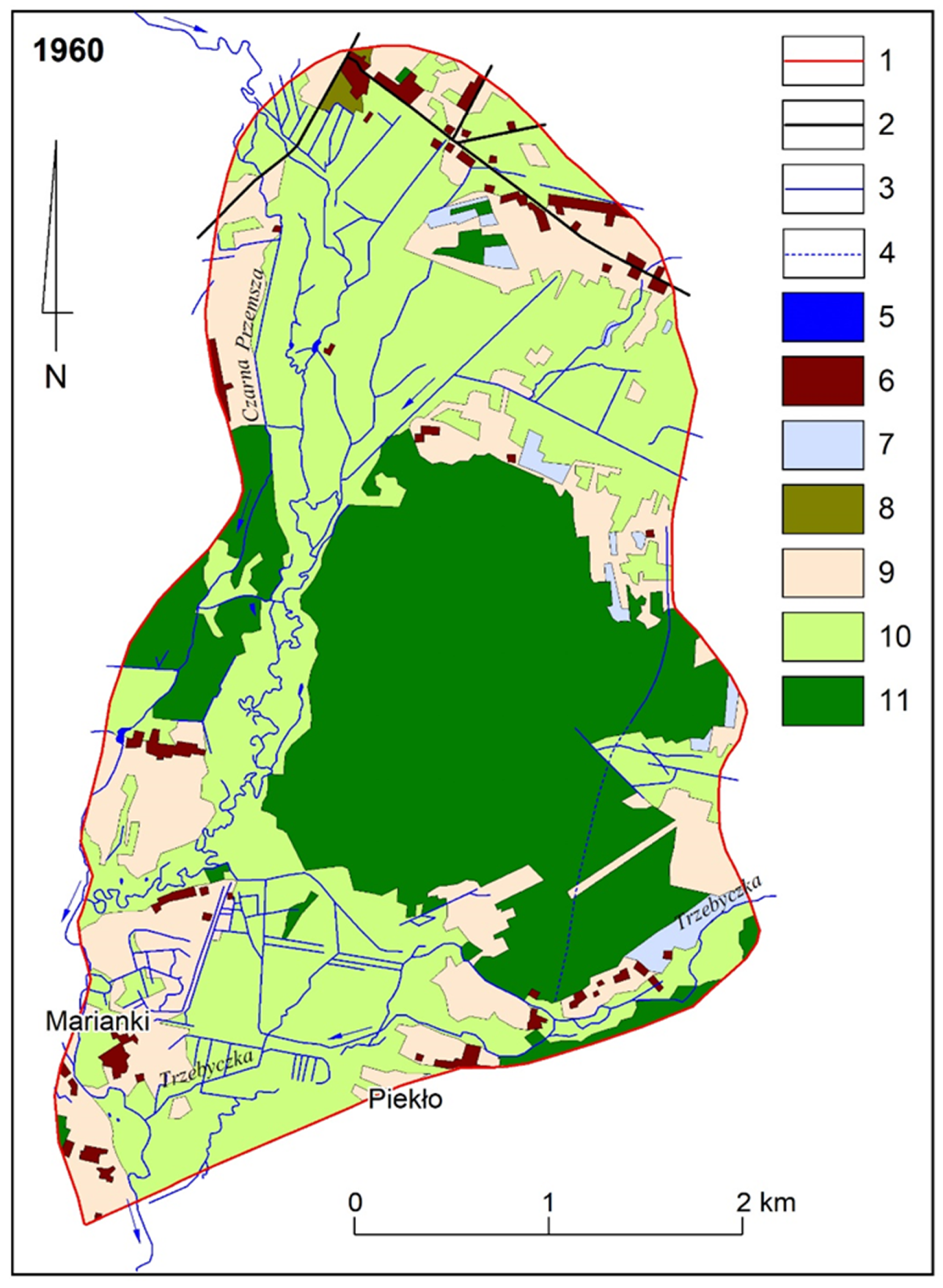
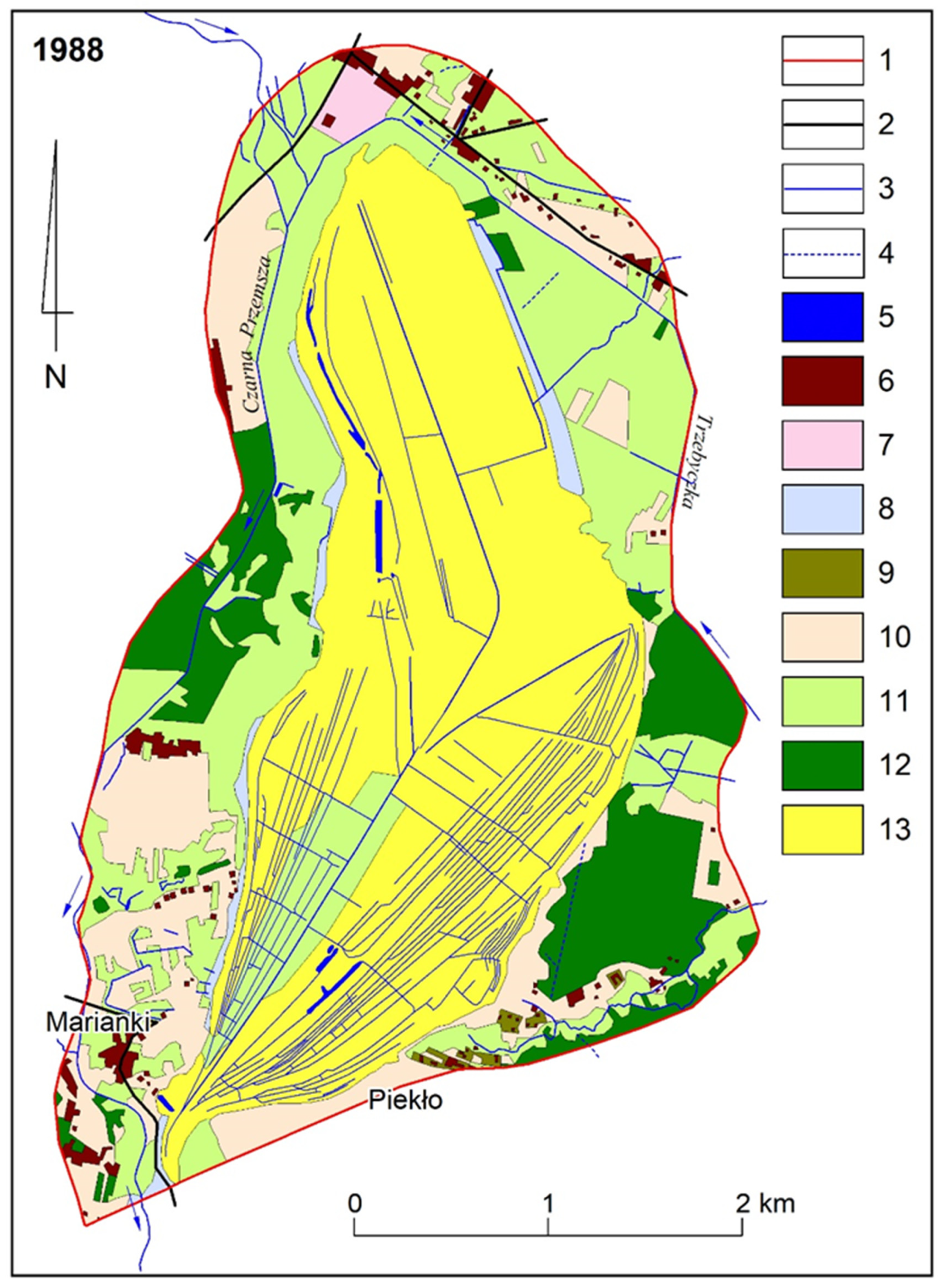
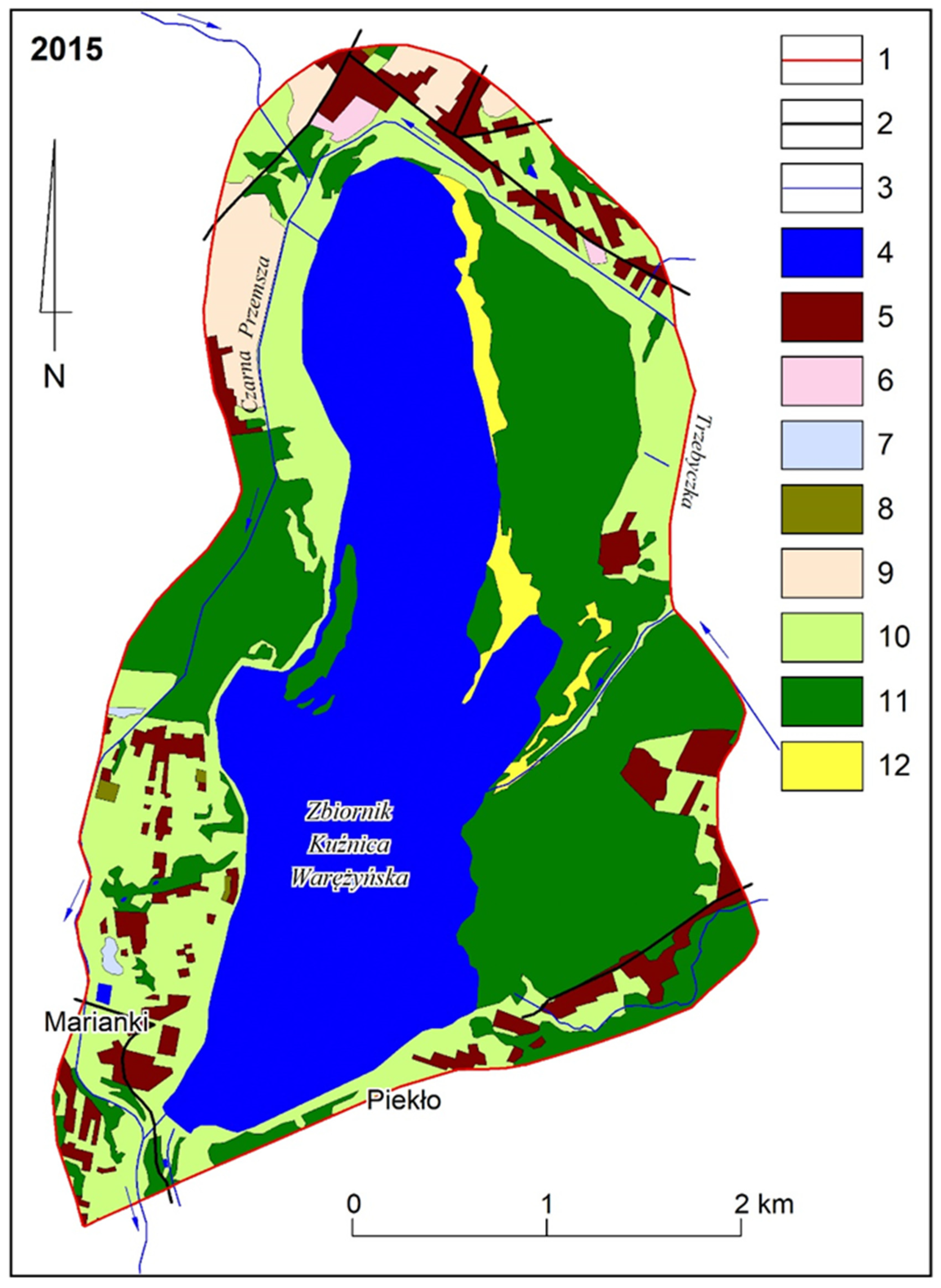
| Land Cover | Area in the Following Years [km2] | |||
|---|---|---|---|---|
| 1944 | 1960 | 1988 | 2015 | |
| Water reservoirs | 0.00 | 0.01 | 0.05 | 4.88 |
| spatial development | 0.20 | 0.29 | 0.25 | 0.97 |
| Industrial areas | 0.00 | 0.00 | 0.10 | 0.05 |
| Wastelands | 0.11 | 0.21 | 0.24 | 0.02 |
| Urban greenery | 0.00 | 0.03 | 0.04 | 0.02 |
| Arable land | 7.03 | 2.70 | 2.04 | 0.47 |
| Meadows and pastures | 3.15 | 6.38 | 4.00 | 3.20 |
| Forests and groups of trees | 3.89 | 4.75 | 1.57 | 4.50 |
| Sand pit, sands and beaches | 0.00 | 0.00 | 6.09 | 0.27 |
| Total area: | 14.37 | 14.37 | 14.37 | 14.37 |
| Sum of watercourses lengths [km]: | 19.96 | 58.54 | 103.29 | 14.73 |
| Hydrochemical Element | (1) Groundwater First Half 1960 | (2) Groundwater 1967–1968 | (3) Collective Mine Water 1990–2004 | (4) Groundwater 2007–2008 | (5) Surface Water 2007–2008 |
|---|---|---|---|---|---|
| DR/TDS [mg/L] | 175–3006/ | 185–5486/ | 350–5516/ | 148–1210 | 310–360 |
| pH | 6.7–7.5 | no data | 7.5–8.1 | 5.01–7.20 | 7.75–8.36 |
| Ca [mg/L] | 10–50 | 43–115 | no data | 18–232 | 62–75 |
| Mg [mg/L] | 3.0–15 | 7.6–32 | no data | 3.7–64 | 15–22 |
| Na [mg/L] | 1.0–10 | 5–25 | 8.0–33 | 2.6–76 | 13–18 |
| K [mg/L] | 0.5–3.0 | 2–4.5 | 2.6–6.5 | 1.0–25 | 3.5–5.5 |
| NH4 [mg/L] | 0.0–0.005 | 0.16–0.80 | 0.003–1.48 | 0.02–1.0 | 0.05–0.28 |
| HCO3 [mg/L] | 120–250 | no data | no data | 9.2–518 | 168–207 |
| SO4 [mg/L] | 25–50 | 30–211 | 71–160 | 37–367 | 63–79 |
| Cl [mg/L] | 10–20 | 10–42 | 27–44 | 2.7–167 | 12–32 |
| NO3 [mg/L] | 0.0–0.005 | 0.0–0.24 | 0.002–8.1 | 0.0–95 | 1.5–16 |
| NO2 [mg/L] | 0.0–0.0002 | 0.003–0.02 | 0.01–0.46 | 0.0–2.2 | 0 |
| Fe [mg/L] | 0.0–1.0 | 2.4–12.2 | 0.1–0.75 | 0.02–3.4 | 0.02–0.09 |
| Mn [mg/L] | 0.0–0.02 | 0.39–1.46 | 0.03–0.30 | 0.004–0.212 | 0.004–0.035 |
| Natural habitats | Vascular plants |
|---|---|
| (7230) Alkaline fens (3130) Oligotrophic to mesotrophic standing waters with vegetation of the Littorelletea uniflorae and/or of the Isoëto-Nanojuncetea (7140) Transition mires and quaking bogs (91E0) Alluvial forests with Alnus glutinosa and Fraxinus excelsior (Alno-Padion, Alnion incanae, Salicion albae) (3140) Hard oligo-mesotrophic waters with benthic vegetation of Chara spp. | Liparis loeselii * * with status by IUCN red List (2018) “Near threatenet” |
| Birds listed in the Annex I of the Birds Directive (Council Directive 2009/147/EC on the conservation of wild birds) and amphibians listed in the Annex IV of the Habitats Directive | |
| Birds | Amphibians |
| Ichthyaetus melanocephalus, Sterna hirundo, Sternula albifrons, Lullula arborea, Lanius collurio, Corydalla campestris, Alcedo atthis * * Breeding species. In total, 43 species listed in the Annex I of the Birds Directive were found. | Bufo viridis, Epidalea calamita, Hyla arborea, Pelobates fuscus. |
© 2020 by the authors. Licensee MDPI, Basel, Switzerland. This article is an open access article distributed under the terms and conditions of the Creative Commons Attribution (CC BY) license (http://creativecommons.org/licenses/by/4.0/).
Share and Cite
Różkowski, J.; Rahmonov, O.; Szymczyk, A. Environmental Transformations in the Area of the Kuźnica Warężyńska Sand Mine, Southern Poland. Land 2020, 9, 116. https://doi.org/10.3390/land9040116
Różkowski J, Rahmonov O, Szymczyk A. Environmental Transformations in the Area of the Kuźnica Warężyńska Sand Mine, Southern Poland. Land. 2020; 9(4):116. https://doi.org/10.3390/land9040116
Chicago/Turabian StyleRóżkowski, Jacek, Oimahmad Rahmonov, and Artur Szymczyk. 2020. "Environmental Transformations in the Area of the Kuźnica Warężyńska Sand Mine, Southern Poland" Land 9, no. 4: 116. https://doi.org/10.3390/land9040116
APA StyleRóżkowski, J., Rahmonov, O., & Szymczyk, A. (2020). Environmental Transformations in the Area of the Kuźnica Warężyńska Sand Mine, Southern Poland. Land, 9(4), 116. https://doi.org/10.3390/land9040116





